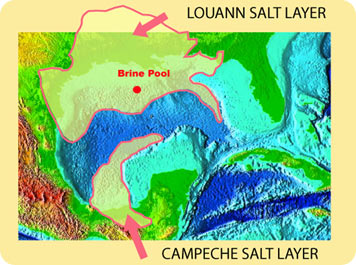Lakes dot the bottom of the Gulf of Mexico: salt lakes − as salty as Great Salt Lake in Utah. They’re infused with a smelly brew of sulfur, hydrogen, methane, and other chemicals. And while that’s not a pleasant environment for most marine life, it does support lots of microscopic life.

These lakes are known as brine pools. They’re the result of processes deep beneath the ocean floor.
Thick layers of salt underlie the Gulf off the coasts of the United States and the Yucatan peninsula. Cracks in the layers of rock above them allow some of the salt to percolate into the Gulf. The salt is frequently mixed with oil, methane, and other compounds.
This brew is several times saltier than normal ocean water. That makes it denser than the ocean, so it settles in depressions and valleys on the Gulf floor. Some of them are only a few feet across, while others can span miles.
The brine pools are generally warmer than the water above them − in some cases, almost 20 degrees warmer. There’s little oxygen in the pools, and most of them are so deep that there’s little light.
No fish or crabs or other large creatures can live in these conditions. But researchers have found large colonies of microbes. In fact, some brine pools have a hundred times more microbes than the water layers above them. In some cases, mussels surround the pools and feed on the microbes.
So no matter how extreme the conditions

